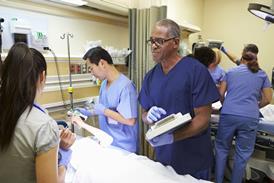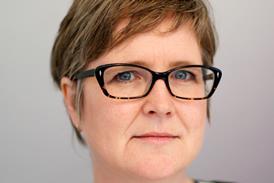Staffing is the issue keeping NHS leaders awake at night - and which consumes two-thirds of trusts’ spending. The fortnightly The Ward Round newsletter, by HSJ workforce correspondent Annabelle Collins, will make sure you are tuned in to the daily pressures on staff, and the wider trends and policies shaping the workforce. Contact me in confidence.
Professor Steve Powis has announced that, after lying largely dormant for months, the Nightingale hospitals in Manchester, Sunderland and Harrogate would be “mobilised in the coming weeks”.
This was in response to the steep rise of covid cases and hospital admissions in northern England and fears that acute hospitals --- probably led by those in Liverpool --- could soon become overwhelmed.
These make-shift hospitals --- unlike the London Nightingale --- are not expected to treat patients needing ventilation but more likely, if they are to be used, to provide step-down care.
Professor Powis said during the same briefing, however, that staff would not be put back on emergency rotas, because national leaders are very reluctant to disrupt elective and cancer care once again.
So how will the Nightingales be staffed if they are needed? The same could be asked of any other expanded capacity, such as shifting services from covid-hit sites into available cold sites.
There is a feeling of déjà vu. At the beginning of April The Ward Round asked the very same question and highlighted the additional pressure that opening Nightingale facilities would put on specialist critical care clinicians.
The prospect of new “redeployment" is bound to make staff feel the same fear and anxiety experienced during the first wave, and for many this has never really abated.
More than six months have passed, but it seems the government and NHS leadership have not learnt from past mistakes.
Alison Leary, professor of healthcare and workforce modelling at London South Bank University, said there have been “a number of opportunities to leverage a supplementary workforce” to help, rather than look to move staff from other services.
“Nursing is a good example of this and with just half of registrants working in the NHS, but many others working in areas such as research, education, industry and the third sector, it may have been possible to utilise that talent,” Professor Leary said.
At the NHS Providers conference last week NHS chief people officer Prerana Issar described three “supply levers” of staffing during the pandemic: returners, retention and sickness absence.
All these have their limitations.
But in reality, how many returners were called upon? The signs suggest not very many, and there are concerns about whether those who volunteered have been looked after, or trained up as may be needed, for example.
And with covid spreading, affecting individuals directly and via family/childcare, without a robust staff testing regime, can absence be kept down?
Nicki Credland, chair of the British Association of Critical Care nurses, has consistently called for more government attention to be given to specialist staff numbers.
“We’re having exactly the same conversations [as we did back in March]. We haven’t got four times more critical care nurses to use these extra ventilators,” Ms Credland said.
“Where will we get the staff from to look after the increase in covid patients?” she said. “There needs to be a clear understanding prevention is better than treatment. If we end up seeing what we saw in March and April but without the extra support, we are in a mess.”
Every time a politician is quoted reassuring the public there are more ventilators available this time round, those who know about NHS staffing will be hit with the same sinking feeling. They know more equipment is just part of the solution.
No clarity for clear masks
Frontline staff are desperately needed in the health service, now more than ever, so it is particularly shocking some are still unable to work clinically, as the clear face masks procured by the government over the summer are still not accepted in clinical settings by some trusts.
Some context: in September, the Department of Health and Social announced health and care workers would be given clear masks to help support communication between patients and clinicians and care workers.
However, according to the British Academy of Audiology, only about 50,000 masks were delivered from US-based company ClearMask, resulting in around 100 per trust.
Although the masks have been approved by the Health and Safety Executive for use in healthcare settings, they come with limitations; they should not be used for surgical/invasive procedures; where there is excessive splashing or spraying of body fluid or as an alternative to a filtering face-piece respirator.
And despite this guidance some trusts have told staff the masks should only be used when “absolutely necessary”.
For months, Fizz Izagaren has been campaigning and working with deaf organisations and the DHSC to try and find solutions to the communication issues caused by face masks.
“Ultimately the needs of deaf healthcare professionals has been forgotten and our careers are at risk if we don't have clear masks or solutions that we can use in clinical settings that would enable us to do our jobs to the best of our abilities,” Dr Izagarden, a paediatric registrar working in London, said.
“Patients with communication needs are at significant risk of substandard clinical care as a result of not being able to communicate in a method requiring lipreading and/or facial expressions that best suits them,” she added.
She called on the government and the NHS England to incentivise UK manufacturers to design transparent masks that would pass testing standards to be use safely in frontline environments.
The Ward Round is keen to hear more from readers working in trusts – are you allowing clinicians to wear clear masks? Do you have enough? As ever, you can contact me directly and confidentially.



























2 Readers' comments